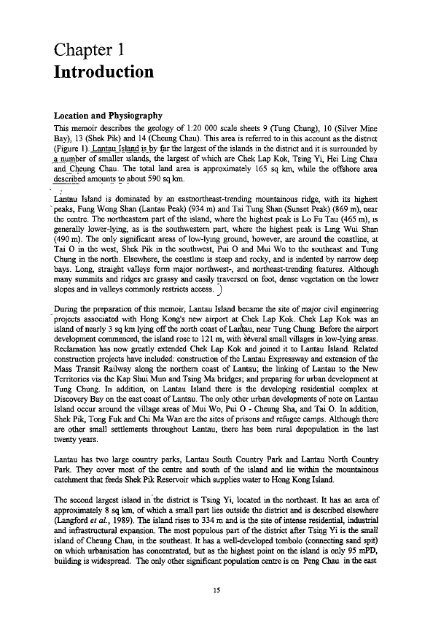1 - HKU Libraries
1 - HKU Libraries
1 - HKU Libraries
You also want an ePaper? Increase the reach of your titles
YUMPU automatically turns print PDFs into web optimized ePapers that Google loves.
Chapter 1IntroductionLocation and PhysiographyThis memoir describes the geology of 1:20 000 scale sheets 9 (Tung Chung), 10 (Silver MineBay), 13 (Shek Pik) and 14 (Cheung Chau). This area is referred to in this account as the district(Figure 1). JLantau Jsland is_by far the largest of the islands in the district and it is surrounded byjajttumber of smaller islands, the largest of which are Chek Lap Kok, Tsing Yi, Hei Ling ChauandjCheung Chau. The total land area is approximately 165 sq km, while the offshore arearibed amounts to about 590 sq km.Lantau Island is dominated by an eastnortheast-trending mountainous ridge, with its highestpeaks, Fung Wong Shan (Lantau Peak) (934 m) and Tai Tung Shan (Sunset Peak) (869 m), nearthe centre. The northeastern part of the island, where the highest peak is Lo Fu Tau (465 m), isgenerally lower-lying, as is the southwestern part, where the highest peak is Ling Wui Shan(490 m). The only significant areas of low-lying ground, however, are around the coastline, atTai O in the west, Shek Pik in the southwest, Pui 0 and Mui Wo to the southeast and TungChung in the north. Elsewhere, the coastline is steep and rocky, and is indented by narrow deepbays. Long, straight valleys form major northwest-, and northeast-trending features. Althoughmany summits and ridges are grassy and easily traversed on foot, dense vegetation on the lowerslopes and in valleys commonly restricts access. )During the preparation of this memoir, Lantau Island became the site of major civil engineeringprojects associated with Hong Kong's new airport at Chek Lap Kok. Chek Lap Kok was anisland of nearly 3 sq km lying off the north coast of LanW, near Tung Chung. Before the airportdevelopment commenced, the island rose to 121 m, with several small villages in low-lying areas.Reclamation has now greatly extended Chek Lap Kok and joined it to Lantau Island. Relatedconstruction projects have included: construction of the Lantau Expressway and extension of theMass Transit Railway along the northern coast of Lantau; the linking of Lantau to the NewTerritories via the Kap Shui Mun and Tsing Ma bridges; and preparing for urban development atTung Chung. In addition, on Lantau Island there is the developing residential complex atDiscovery Bay on the east coast of Lantau. The only other urban developments of note on LantauIsland occur around the village areas of Mui Wo, Pui 0 - Cheung Sha, and Tai 0. In addition,Shek Pik, Tong Fuk and Chi Ma Wan are the sites of prisons and refugee camps. Although thereare other small settlements throughout Lantau, there has been rural depopulation in the lasttwenty years.Lantau has two large country parks, Lantau South Country Park and Lantau North CountryPark. They cover most of the centre and south of the island and lie within the mountainouscatchment that feeds Shek Pik Reservoir which supplies water to Hong Kong Island.The second largest island in the district is Tsing Yi, located in the northeast. It has an area ofapproximately 8 sq km, of which a small part lies outside the district and is described elsewhere(Langford et al. y 1989). The island rises to 334 m and is the site of intense residential, industrialand infrastructural expansion. The most populous part of the district after Tsirig Yi is the smallisland of Cheung Chau, in the southeast. It has a well-developed tombolo (connecting sand spit)on which urbanisation has concentrated, but as the highest point on the island is only 95 mPD,building is widespread. The only other significant population centre is on Peng Chau in the east15

















